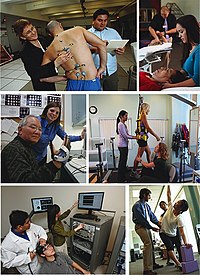
Photo from wikipedia
The epidermis in plants is the outermost cell layer and as such is crucial to mediate the plant’s interaction with its environment. In aerial tissues like leaves and stems, the… Click to show full abstract
The epidermis in plants is the outermost cell layer and as such is crucial to mediate the plant’s interaction with its environment. In aerial tissues like leaves and stems, the epidermis protects the plant from the threats of pathogens, herbivores, and unfavorable environmental conditions. Meanwhile, the root epidermis actively increases the roots’ surface to favor water and nutrient intake, as well as to establish symbiotic relationships with beneficial fungi. To carry out such a diverse number of functions, epidermal cells can differentiate into aerial hairs or trichomes, stomata, or root hairs, among others. In some plants, trichomes act as a direct defence mechanism as they accumulate herbivore-deterrent chemicals, while in Arabidopsis (Arabidopsis thaliana) trichomes act as mechanosensors, initiating Ca + waves that reach and alert distant cells of the presence of a threat (Matsumura et al., 2022). However, not all epidermal cells differentiate into trichomes or root hairs. Specific genes regulate epidermal cell fate and therefore the ratio of epidermal cell types (Zuch et al., 2022). For example, GLABRA2 (GL2) encodes a transcription factor (TF) and is one of the best characterized regulators of epidermal cell fate in Arabidopsis, controlling trichome differentiation, root hair-less cell file determination, as well as mucilage synthesis in seeds (for review, see Ariel et al., 2007). TFs bind specific DNA sequences (or target sites) and execute changes in the expression of genes, usually by recruiting additional TFs and components of the basal transcriptional machinery. TFs are modular molecules comprising distinct protein domains, each of which typically contributes to the TF activity in a different manner: the DNA binding domain determines the DNA sequence to which the TF will bind, whereas other protein domains may influence the TF’s protein interactome, intracellular transport dynamics, and protein stability. Distinguishing the contributions of individual protein domains in a TF is crucial to harness their full potential to fine-tune transcription for better yields or to efficiently design synthetic transcriptional networks (Khalil et al., 2012). GL2 belongs to the homeodomain-leucine zipper (HDZIP) class IV TF family that has a plant-specific domain arrangement consisting of an HD-ZIP DNA-binding domain tandem near the N-terminus, followed by a steroidogenic acute regulatory protein-related lipid-transfer (START) domain, and a START-associated domain (STAD) near the protein C-terminus (Schena and Davis, 1992). In animals and the liverwort Marchantia polymorpha, the START domain binds to lipids and influences their transport (Clark, 2020; Hirashima et al., 2021). Nevertheless, the functional contribution of the START domain to GL2 transcriptional activity has remained speculative until now. In the current issue of Plant Physiology, Mukherjee et al. (2022) molecularly dissect and characterize the roles of the START domain in GL2 function as well as its interactions with the better-characterized HD-ZIP domains. The approach taken by Mukherjee et al. (2022) involved designing a comprehensive set of GL2 mutant variants that could potentially impair the HD and START domain activities. Knockout gl2 plants were transformed with the set of GL2 variants fused to a fluorescent protein, and their individual capacity to rescue the well-characterized gl2 developmental defects was scored. Confirming the predictive power of homology-based structural models, all mutant variants of GL2 failed to rescue gl2 trichome development, root hair density, and seed mucilage accumulation, indicating that the START domain, similarly to HD, is indispensable for GL2 transcriptional function. Similar phenotypic defects were quantified in domain-specific START and HD mutants, indicating that both domains are equally necessary for GL2 activity. N ew s an d V ie w s
Journal Title: Plant Physiology
Year Published: 2022
Link to full text (if available)
Share on Social Media: Sign Up to like & get
recommendations!